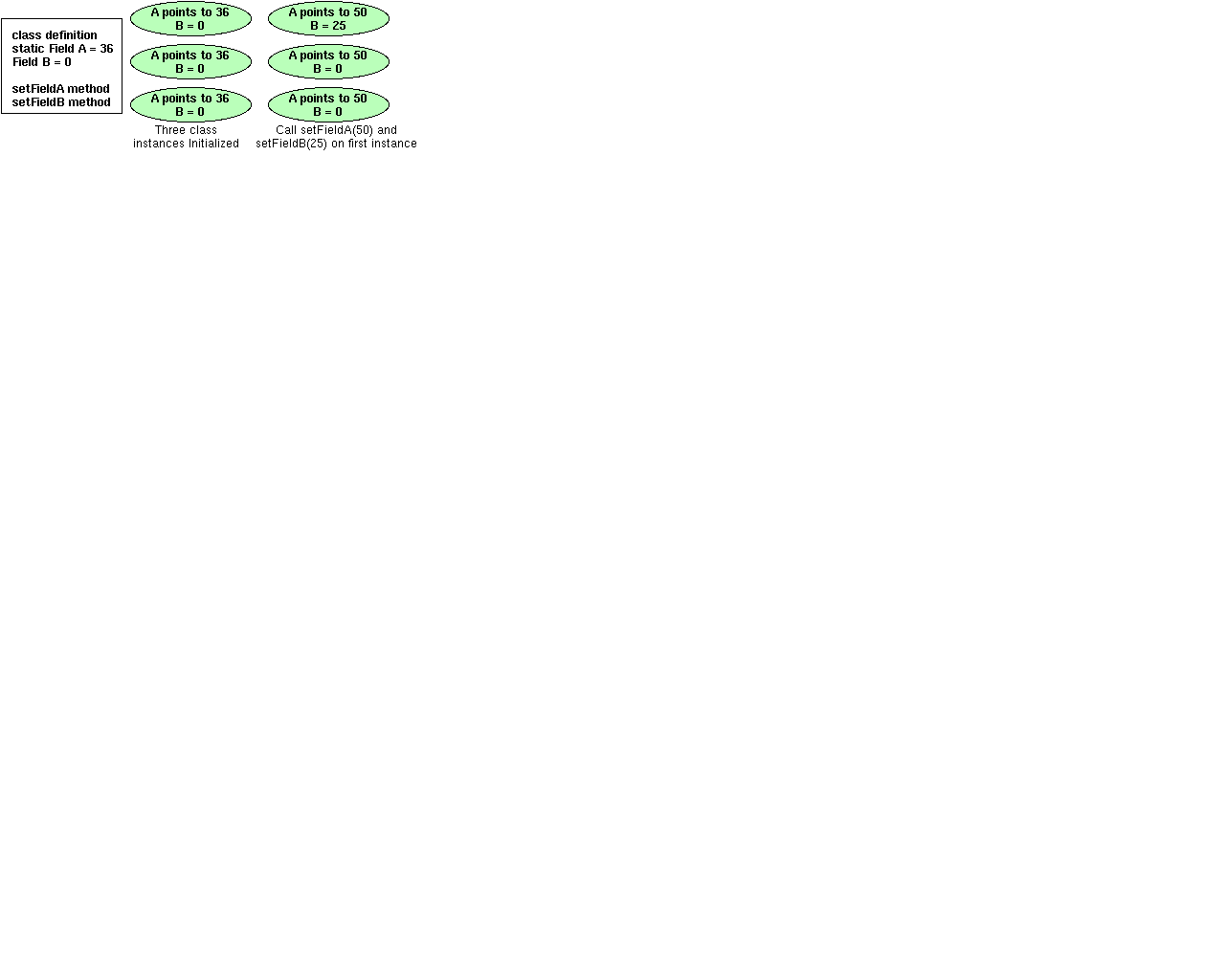|
All programs written in the JavaTM language (Java programs)
are built from classes. Because all classes have the same
structure and share common elements, all Java programs are very similar.
This lesson describes the structure and elements of a simple
application created from one class. The next lesson covers the same
material for applets.
Application Structure and Elements
 An application is created from classes.
A
An application is created from classes.
A class is similar to a RECORD
in the Pascal language or a struct in the
C language in that it stores related data in fields,
where the fields can be different types. So you could, for
example, store a text string in one field, an integer in another field,
and a floating point in a third field.
The difference between a class and a RECORD or
struct is that a class also defines the
methods to work on the data.
For example, a very simple class might store a string of text
and define one method to set the string and another method
to get the string and print it to the console.
Methods that work on the data are called accessor methods.
 Every application needs one class with a
Every application needs one class with a main
method. This class is the entry point for the program, and is
the class name passed to the
java interpreter command to run the application.
The code in the main method executes first when the
program starts, and is the control point from which the controller
class accessor methods are called to work on the data.
Here, again, is the
example program
from Lesson 1. It has no fields
or accessor methods, but because it is the only class in the
program, it has a main method.
class ExampleProgram {
public static void main(String[] args){
System.out.println("I'm a Simple Program");
}
}
The public static void keywords mean the Java1 virtual
machine (JVM) interpreter
can call the program's main method to start the program (public)
without creating an instance of the class (static), and the program
does not return data to the Java VM interpreter (void) when it
ends.
 An instance of a class is an executable
copy of the class While the class describes the
data and behavior, you need a class instance to
acquire and work on data.
The diagram at the left shows three instances of
the
An instance of a class is an executable
copy of the class While the class describes the
data and behavior, you need a class instance to
acquire and work on data.
The diagram at the left shows three instances of
the ExampleProgram class by the names:
FirstInstance, SecondInstance
and ThirdInstance.
The main method is static to give the Java VM
interpreter a way to start the class without creating an
instance of the control class first. Instances of
the control class are created in the main
method after the program starts.
The main method for the simple example does not create an
instance of the
ExampleProgram class because none is needed.
The ExampleProgram class has no
other methods or fields, so no class instance is needed to access them
from the main method. The Java platform lets you execute a
class without creating an
instance of that class as long as its static methods do not call any non-static
methods or fields.
The ExampleProgram class just calls println,
which is a static method in the
System class. The java.lang.System class, among
other things, provides
functionality to send text to the terminal window where the program was started.
It has all static fields and methods.
The static fields and methods of a class can be called by another program without
creating an instance of the class. So, just as the Java VM interpreter command
could call the static main method in the ExampleProgram
class without creating an instance of the ExampleProgram class,
the ExampleProgram class can call the
static println method in the System class, without
creating an instance of the System class.
However, a program must create an instance of a class to access its non-static
fields and methods. Accessing static and non-static fields and methods is
discussed further with several examples in the next section.
Fields and Methods
The LessonTwoA.java program
alters the simple example to store the text string in
a static field called text. The text field
is static so its data can be accessed directly without creating an
instance of the LessonTwoA class.
class LessonTwoA {
static String text = "I'm a Simple Program";
public static void main(String[] args){
System.out.println(text);
}
}
The LessonTwoB.java and
LessonTwoC.java programs
add a getText method to the program to
retrieve and print the text.
The LessonTwoB.java program
accesses the non-static text field with the non-static
getText method. Non-static methods and fields are called
instance methods and fields. This approach requires that an instance
of the LessonTwoB class be created in the
main method. To keep things interesting, this example
includes a static text field and a non-static instance method
(getStaticText) to retrieve it.
Note: The field and method return values
are all type String.
class LessonTwoB {
String text = "I'm a Simple Program";
static String text2 = "I'm static text";
String getText(){
return text;
}
String getStaticText(){
return text2;
}
public static void main(String[] args){
LessonTwoB progInstance = new LessonTwoB();
String retrievedText = progInstance.getText();
String retrievedStaticText =
progInstance.getStaticText();
System.out.println(retrievedText);
System.out.println(retrievedStaticText);
}
}
The LessonTwoC.java program
accesses the static text field with the
static getText method. Static methods and fields are called
class methods and fields. This approach allows the program to
call the static getText method directly without creating
an instance of the LessonTwoC class.
class LessonTwoC {
static String text = "I'm a Simple Program";
//Accessor method
static String getText(){
return text;
}
public static void main(String[] args){
String retrievedText = getText();
System.out.println(retrievedText);
}
}
So, class methods can operate only on class fields, and instance
methods can operate on class and instance fields.
You might wonder what the difference means. In short, there is only
one copy of the data stored or set in a class field but each instance has
its own copy of the data stored or set in an instance field.

The figure above shows three class instances with one static field and one instance
field. At runtime, there is one copy of the value for static Field A and
each instance points to the one copy. When setFieldA(50) is called on the
first instance, the value of the one copy changes from 36 to 50 and all
three instances point to the new value. But, when setFieldB(25) is called
on the first instance, the value for Field B changes from 0 to 25
for the first instance only because each instance has its own copy of
Field B.
See
Understanding Instance and Class Members lesson in
The Java tutorial for a
thorough discussion of this topic.
Constructors
Classes have a special method called a constructor that is called
when a class instance is created. The class constructor always has the
same name as the class and no return type.
The LessonTwoD program converts the
LessonTwoB program to use a constructor to initialize the
text string.
Note: If you do not write your own constructor,
the compiler adds an empty constructor, which calls the no-arguments constructor of its parent class. The empty constructor
is called the default constructor. The default constructor
initializes all non-initialized fields and variables to zero.
class LessonTwoD {
String text;
//Constructor
LessonTwoD(){
text = "I'm a Simple Program";
}
//Accessor method
String getText(){
return text;
}
public static void main(String[] args){
LessonTwoD progInst = new LessonTwoD();
String retrievedText = progInst.getText();
System.out.println(retrievedText);
}
}
To Summarize
A simple program that prints a short text string to the console
would probably do everything in the main method
and do away with the constructor, text field, and
getText method. But, this lesson used a very simple
program to show you the structure and elements in a basic
Java program.
More Information
See
Understanding
Instance and Class Members lesson in
The Java
tutorial for a thorough discussion of this topic.
_______
1 As used on this web site,
the terms "Java virtual
machine" or "JVM" mean a virtual machine
for the Java platform.
[TOP]
|

